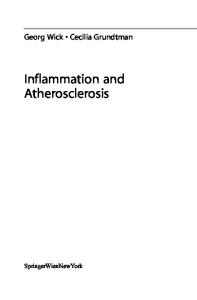Atherosclerosis
The World Health Organisation reported that in 2012 cardiovascular diseases were responsible for 31 % of all world deaths. The largest contributor to deaths from cardiovascular disease is atherosclerosis. This chapter will explore atherosclerosis, its dev
- PDF / 14,053,151 Bytes
- 462 Pages / 453.543 x 683.15 pts Page_size
- 59 Downloads / 263 Views
ovascular Biomechanics
Cardiovascular Biomechanics
Peter R. Hoskins Patricia V. Lawford Barry J. Doyle •
Editors
Cardiovascular Biomechanics
123
Editors Peter R. Hoskins Centre for Cardiovascular Science, Queens Medical Research Institute University of Edinburgh Edinburgh UK
Barry J. Doyle School of Mechanical and Chemical Engineering University of Western Australia Perth, WA Australia
Patricia V. Lawford Department of Infection, Immunity and Cardiovascular Disease/Insigneo Institute for in silico Medicine University of Sheffield Sheffield UK
ISBN 978-3-319-46405-3 DOI 10.1007/978-3-319-46407-7
ISBN 978-3-319-46407-7
(eBook)
Library of Congress Control Number: 2016950902 © Springer International Publishing Switzerland 2017 This work is subject to copyright. All rights are reserved by the Publisher, whether the whole or part of the material is concerned, specifically the rights of translation, reprinting, reuse of illustrations, recitation, broadcasting, reproduction on microfilms or in any other physical way, and transmission or information storage and retrieval, electronic adaptation, computer software, or by similar or dissimilar methodology now known or hereafter developed. The use of general descriptive names, registered names, trademarks, service marks, etc. in this publication does not imply, even in the absence of a specific statement, that such names are exempt from the relevant protective laws and regulations and therefore free for general use. The publisher, the authors and the editors are safe to assume that the advice and information in this book are believed to be true and accurate at the date of publication. Neither the publisher nor the authors or the editors give a warranty, express or implied, with respect to the material contained herein or for any errors or omissions that may have been made. Printed on acid-free paper This Springer imprint is published by Springer Nature The registered company is Springer International Publishing AG The registered company address is: Gewerbestrasse 11, 6330 Cham, Switzerland
Preface
This book is concerned with cardiovascular biomechanics; this is the study of the function and the structure of the cardiovascular system using the methods of mechanics. It has become clear that this area lies at the heart of all the major cardiovascular diseases such as atherosclerosis and aneurysms; diseases which are responsible for some one-third of world’s deaths. The underpinning principle which will be referred to several times in this book is that the cardiovascular system adapts in order to normalise its own mechanical environment. The cardiovascular system is able to do this because mechanical forces are sensed by tissues, and deviations from 'normal' result in biological changes which affect structure. The study of cardiovascular biomechanics therefore requires an interdisciplinary approach involving biology, medicine, physics, engineering and mathematics. This book is an introductory text suitable for students and practitioners in all these different fields. The
Data Loading...











